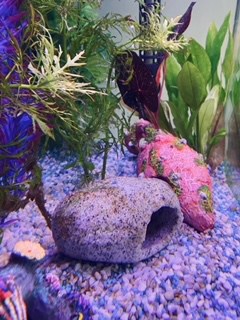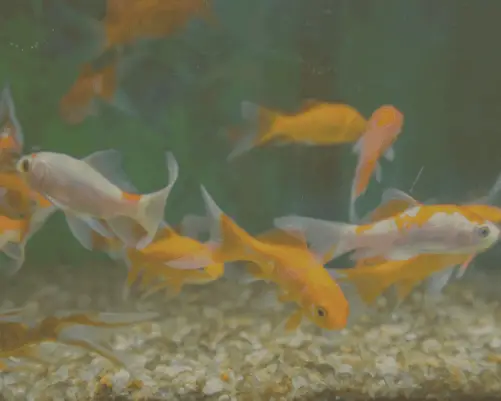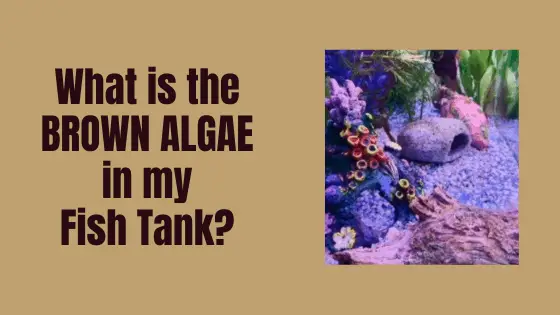The very unsightly brown algae is a common occurrence, especially in new set ups.

Brown algae isn’t actually an algae. It is a type of diatom that can be found in your new tropical fish tank water. The brown layer of dusty diatoms will appear after about two weeks when it is not yet fully cycled.
Diatoms are single cell organisms. They have cell walls which are made up of a mineral called silica. This is oxygen and silicone. This acts as a protective shell for them. They are commonly referred to as brown algae.
Why does Brown Algae Appear in a New Tank?
Brown algae will first start to appear at the very start of the cycle. You probably won’t notice anything until approx. 2 weeks in. You will then notice the top of your substrate and ornaments are coated in it.
It looks a lot worse that it is. The colour can vary from anywhere between light to dark brown. Whatever shade it is, it looks awful!
Brown algae in a new tank without fish is confirmation of what you should already know-that your water isn’t ready.
When you first add water to your tank, it needs to go through the nitrogen cycle before adding fish.
You can add ammonia to a new tank to jump-start the cycle, but as it breaks down into nitrates, you will need to add more ammonia. The amount needs to be calculated using how many litres of water are in your tank.
This is known as the ammonia method of fishless tank cycling.
To do this, you need to test the ammonia levels in your water every day.
As the ammonia levels start to drop, you need to keep topping it up while you wait for the nitrites to rise.
Fishkeeping.co.uk have a brilliant article about this, which has a calculator where you input your litre capacity, as well as what your ammonia test has recorded, and it will work out how much ammonia you need to add.
It may take up to a month for the cycle to complete. You should be able to tell when it is coming to an end by how quickly the ammonia levels drop.
Once the nitrite level has spiked, you should start seeing nitrates in your water as well.
When this happens, you should carry on testing each day. Once you’ve had 3 continuous days of zero ammonia and zero nitrites, you should be ready to add some fish.
Silica is present in water. The diatoms start to form as the water hasn’t had time to establish any good bacteria. These diatoms will start to multiply while they have the chance. That is when you start to see it coating your gravel and ornaments.
Brown Algae in an Established Tank.
Brown algae can also form in an established tank if the lighting is poor. This can be controlled by making sure the tank is well lit for at least eight hours a day.
Adding live plants to your tank will also help to keep brown algae under control. There are also certain species of fish you can add that likes to eat brown algae.
Otocinclus Catfish are a good example of this.
Nerite Snails are also great for eating algae.

Is Brown Algae Dangerous?
Brown Algae in a new tank that is cycling is not dangerous. It is actually a natural part of the cycling process.
Brown algae in a established freshwater fish tank is not dangerous as long as it is dealt with promptly.
There could be more danger in the reasons why you have the brown algae in the first place.
It is not dangerous for the fish or any of your plants, but it can make cleaning difficult. It can also affect the water quality if left too long. Brown algae can grow on decorations and live plants. These items should be removed so you can clean them.
Brown algae looks different to freshwater green or black algae. Brown algae looks like slimy, dark-coloured patches rather than the thin lines that come with green and black algal blooms.
It also feels slightly gritty to touch.
And, as explained before, it isn’t actually algae!
How to Get Rid of Brown Algae in a Fish Tank.
It is very easy to get rid of brown algae from an unpopulated fish tank. My advice though is to keep it there for now while nature is doing it’s thing. It will clear up in a week or two anyway, when the good bacteria is formed and starts kicking ass.
If there is still some remaining on the gravel, you should gently mix it so it sinks through the gaps. It will then be killed off when covered by other gravel.
You can use a cleaning pad to clean the front and sides of the tank. It is really easy to wipe off.
Ornaments can be taken out and cleaned with water and rubbed with a cleaning pad to remove the algae.
Removing brown algae from an established tank is more or less the same process. You will be best vacuuming the gravel though, and carrying out a partial water change.
Also make sure that you have sorted out whatever issue is causing it in the first place. It will keep coming back otherwise.
Related Posts:
What causes algae in a fish tank?




